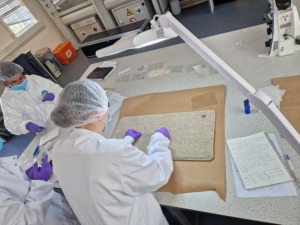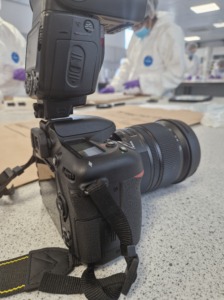Trace Evidence – How the smallest clues can make the largest difference at a crime scene.
30/03/2023

When arriving at a crime scene, there are often signs or physical evidence such as hairs, fibres or shards of material that are often integral to solving how a crime was committed or providing critical evidence if required at a court trial.
The Office for National Statistics (ONS) have tracked the rise in violent crime across the United Kingdom (UK). Since its lowest levels in 2012/13, there has been a dramatic increase of over 600,000 reports per year as last reported in September 2022.
This means that not only are police forces being stretched in their need for both detective and crime scene investigation (CSI) units but also the rise of both emergency service and independent forensic services personnel, who provide invaluable support to recover, examine and present evidence at trial.
Cranfield Forensic Institute (CFI) have been integral in creating the next generation of forensic scientists, investigators and experts. This is underpinned by utilising our breadth of academic staff who are currently practicing in both public and professional services.
In early March 2023 CFI ran the Trace Evidence module. The course ran over a five-day period and included two full days of hands-on work within the dedicated laboratory space at the Cranfield Campus.
The module focuses on trace evidence types such as hairs, fibres and glass that are transferred between surfaces upon contact and non-contact.
What is Trace Evidence?
The transfer of trace evidence and their analysis within forensic science were first discovered and documented by Dr Edmund Locard in early 20th century France.
The identification and analysis of the type and numbers of a particular trace evidence type can be utilised by trace evidence experts to establish if contact between clothing and surfaces has occurred and what type of contact this was to establish links between people and places.
An expert in each of the disciplines within the Trace Evidence arena of forensic science, for example within hairs/fibres/glass analysis, will be able to establish common characteristics of these evidence types, complete experiments and analyse databases in order to establish transfer and persistence of these evidence types within the case scenarios provided.

Students were split into groups and were given the task of investigating and extracting trace evidence from carpet strips
As a very popular module at CFI, it sits within the Forensic Modular Programme. This makes it an elective choice for the majority of the Master’s courses offered at CFI.
The module allows you to work methodically through the process of how to collect evidence or materials of very small scale such as fibres, hairs or blood flecks.
Students started the week with theory-based lectures on the processes, ethics and details of evidence recovery, they were then given a small scale potential crime scene, where they could investigate evidence, analyse any trace materials and finish the module by building a final report which could be used at trial.
The course was attended by 14 students across a number of our MSc’s including the Forensic Investigation MSc.
“It’s great to be really hands-on and do a lot of the things we’ve learnt in the theory sessions. This module really builds on base-line information learnt at undergraduate level”
Reece Smith (Current Forensic Investigation MSc student)

Uncovering the smallest pieces of evidence can be the difference between a verdict at a court trial
Attendees of the course have benefitted since CFI moved home to the Cranfield Campus in 2020. The multi-million-pound investment allowed the University to build dedicated resources for laboratories, teaching spaces and student break-out areas.
It enabled to have both a space to collect the evidence, but also to be transferred and investigated under a microscope in a separate sterile space.
The module leader, Laura Hugh is a practicing Forensic Biologist and will be launching the brand-new Forensic Biology MSc in October 2023.
Discussing the necessity for Forensic Biology expertise and how the Trace Evidence module provides the knowledge to create real-world changes.
“As a forensic biologist we are directly interpreting evidence from crimes, in light of case scenarios in an effort to solve a crime and therefore making a real-life difference within the criminal justice system to help a victim and victim’ family or exonerate a suspect in other cases.”
As of February 2023, there were roughly 5000 active forensic professionals in the UK with 200 graduates being employed each year (source Forensic Science Degrees: The Higher Education Perspective).
Choosing the right role and location is important, but as a leading university in forensic postgraduate degrees. Cranfield is attracting not only recent undergraduates from the UK, but international students from Asia, Europe and America.
“I study and work in Belgium, we don’t really have this type of course. It’s a very unique course, there aren’t many similar courses out there. Also, the elective modules that I could take that aligned with this course were very applicable to me, such as the textile and soil research”
(Griet Kockelkoren, Short Course Student)
This proves that the growing need for forensic expertise is apparent not just in the UK, but worldwide.
The rise of crime-based TV shows and the subsequent interest in further forensic training means this is a growing area is only going to become more popular.
It’s good news for forensic service providers and police forces as they look to kerb the incline in violent crime and bring the perpetrators to court.
You can find out more about Cranfield University’s Forensic Institute here, and build your own career in the world of investigation and justice.
Categories & Tags:
Leave a comment on this post:
You might also like…
Keren Tuv: My Cranfield experience studying Renewable Energy
Hello, my name is Keren, I am from London, UK, and I am studying Renewable Energy MSc. My journey to discovering Cranfield University began when I first decided to return to academia to pursue ...
3D Metal Manufacturing in space: A look into the future
David Rico Sierra, Research Fellow in Additive Manufacturing, was recently involved in an exciting project to manufacture parts using 3D printers in space. Here he reflects on his time working with Airbus in Toulouse… ...
A Legacy of Courage: From India to Britain, Three Generations Find Their Home
My story begins with my grandfather, who plucked up the courage to travel aboard at the age of 22 and start a new life in the UK. I don’t think he would have thought that ...
Cranfield to JLR: mastering mechatronics for a dream career
My name is Jerin Tom, and in 2023 I graduated from Cranfield with an MSc in Automotive Mechatronics. Originally from India, I've always been fascinated by the world of automobiles. Why Cranfield and the ...
Bringing the vision of advanced air mobility closer to reality
Experts at Cranfield University led by Professor Antonios Tsourdos, Head of the Autonomous and Cyber-Physical Systems Centre, are part of the Air Mobility Ecosystem Consortium (AMEC), which aims to demonstrate the commercial and operational ...
Using grey literature in your research: A short guide
As you research and write your thesis, you might come across, or be looking for, ‘grey literature’. This is quite simply material that is either unpublished, or published but not in a commercial form. Types ...






